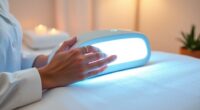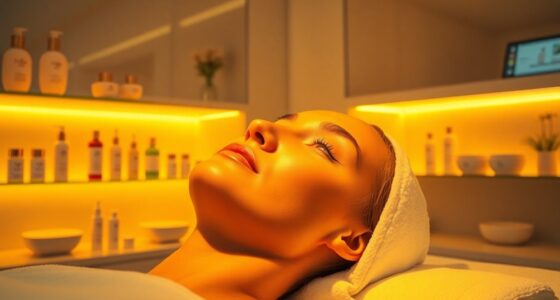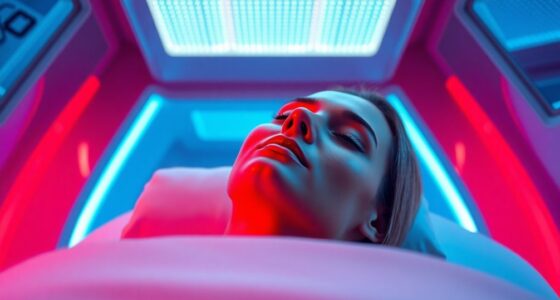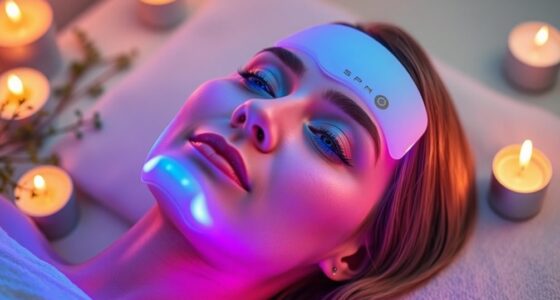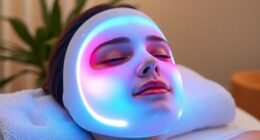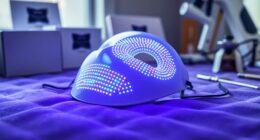LED light therapy is a non-invasive skincare treatment that uses specific light wavelengths to tackle various skin issues. You'll find different colors—like blue for acne and red for boosting collagen—that target specific concerns. It's safe for all skin types and can be easily integrated into your routine with at-home devices like masks or handheld wands. Consistency is key for the best results, and post-treatment care is essential. Be sure to choose quality devices and follow safety guidelines. Keep exploring to discover how to maximize your results and select the best treatments for your unique skin needs.
Key Takeaways
- LED light therapy uses various light wavelengths to address skin issues like acne, aging, and pigmentation safely for all skin types.
- Different colored lights, such as blue for acne and red for collagen production, target specific skin concerns effectively.
- Consistency is key; aim for regular sessions to achieve desired results and maintain skin health.
- Choose quality devices, starting with a patch test, and follow proper skin prep for optimal effectiveness.
- Post-treatment care, including hydration and sun protection, enhances the benefits of LED light therapy.
What Is LED Light Therapy?
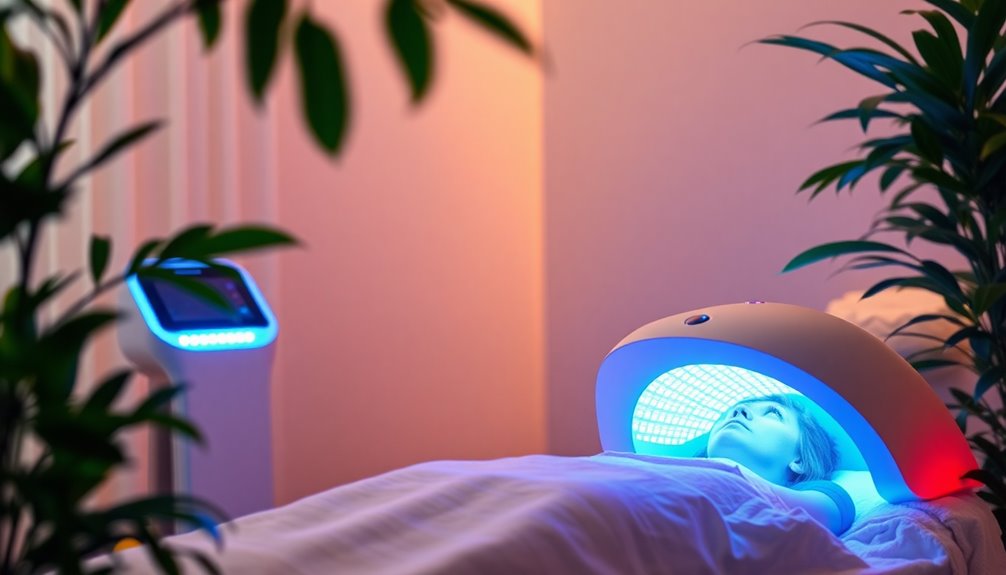
LED light therapy is a cutting-edge, non-invasive treatment that harnesses specific wavelengths of light to address various skin issues.
Using low-level light that's safe for your skin, this therapy employs different colors, including amber, blue, red, and green, each targeting specific concerns. For instance, blue light effectively combats acne-causing bacteria, while red light boosts collagen production, improving skin texture and reducing fine lines. Additionally, LED light therapy utilizes skin-safe, low-level light to minimize the risk of skin damage, making it a favorable option for many individuals.
There are also at-home devices like light masks and wands, making it easy for you to incorporate this treatment into your routine. With medical-grade specifications, LED light therapy is safe for all skin types, and its low heat emission ensures a painless experience.
Consistency is key for achieving the best results.
How LED Light Therapy Works

Light therapy employs specific wavelengths to stimulate various cellular processes in your skin. By targeting different chromophores, like cytochrome c oxidase for red light, the therapy promotes adenosine triphosphate (ATP) production, which fuels essential cellular activities. Red light, for instance, boosts collagen and elastin production, improving your skin's texture and tone. In contrast, blue light targets acne-causing bacteria, reducing breakouts effectively. Each wavelength penetrates the skin at varying depths, ensuring tailored treatment for specific concerns. Additionally, red light therapy is known for its ability to promote wound healing, making it a versatile option for various skin issues. The application involves precise power density and dosage calculations, determining how long and how often you should undergo sessions. This strategic approach maximizes the benefits, making LED light therapy a powerful tool for enhancing your skin's health.
Benefits of LED Light Therapy
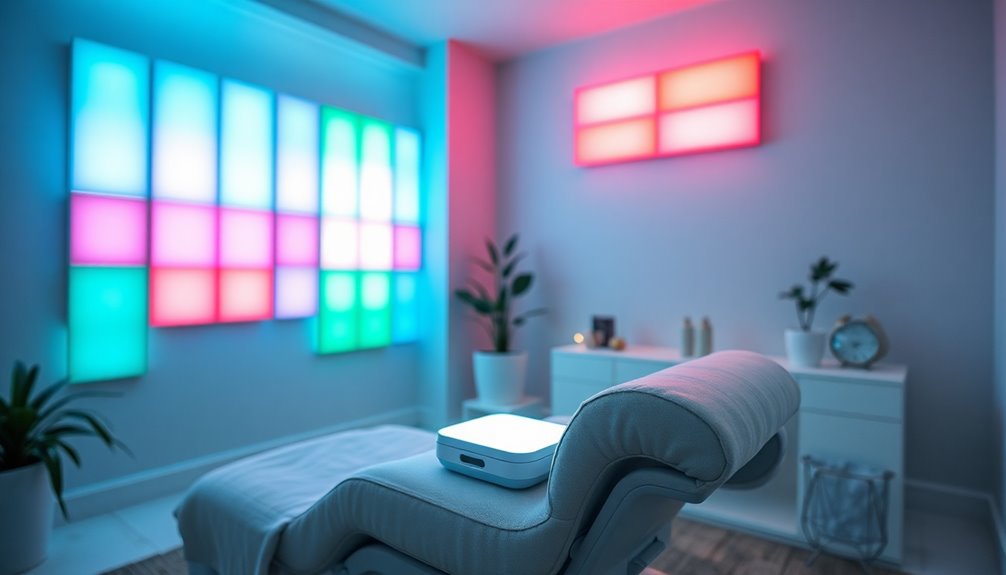
The benefits of LED light therapy are impressive, offering a range of solutions for various skin concerns.
For those struggling with acne, blue light therapy effectively kills acne-causing bacteria, reduces inflammation, and regulates oil production, making it ideal for acne-prone skin. Additionally, this treatment is known for its ability to target specific skin concerns through the use of different light colors.
If you're looking to combat aging, red light therapy boosts collagen production, improving skin texture and reducing fine lines. It also enhances skin elasticity, giving you a smoother, more youthful appearance.
Additionally, LED light therapy aids in wound healing by stimulating collagen and accelerating recovery. It can repair sun-damaged skin, reduce pigmentation, and improve overall skin tone.
Plus, it's a non-invasive treatment suitable for all skin types, providing noticeable results without pain.
Types of LED Light
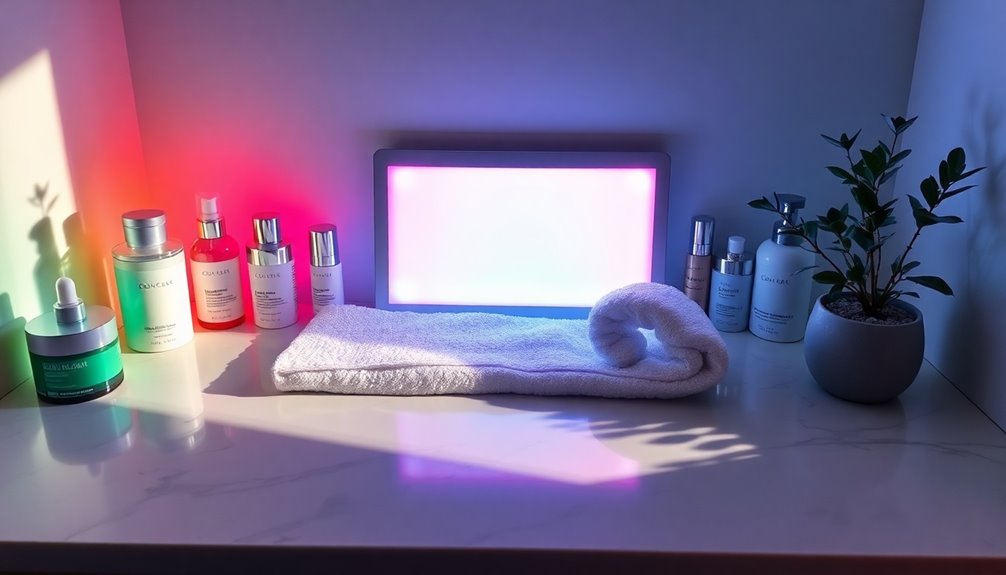
Various types of LED light provide targeted solutions for different skin concerns, each with unique benefits.
Blue light is great for treating acne and speeding up wound healing by reducing oil production and killing bacteria.
Red light penetrates deeper, stimulating collagen production to diminish scars and signs of aging. LED light therapy is non-invasive and suitable for treating a variety of skin conditions.
Near-infrared light goes even deeper, enhancing skin elasticity and reducing pain and inflammation.
Other colors like yellow reduce melanin and redness, while white light accelerates cell growth and healing.
Cyan light tackles acne and pigmented stains, and purple light promotes cell regeneration and reduces acne scars.
Each type offers specific therapeutic effects, so you can choose the one that best addresses your needs.
Myths About LED Light Therapy
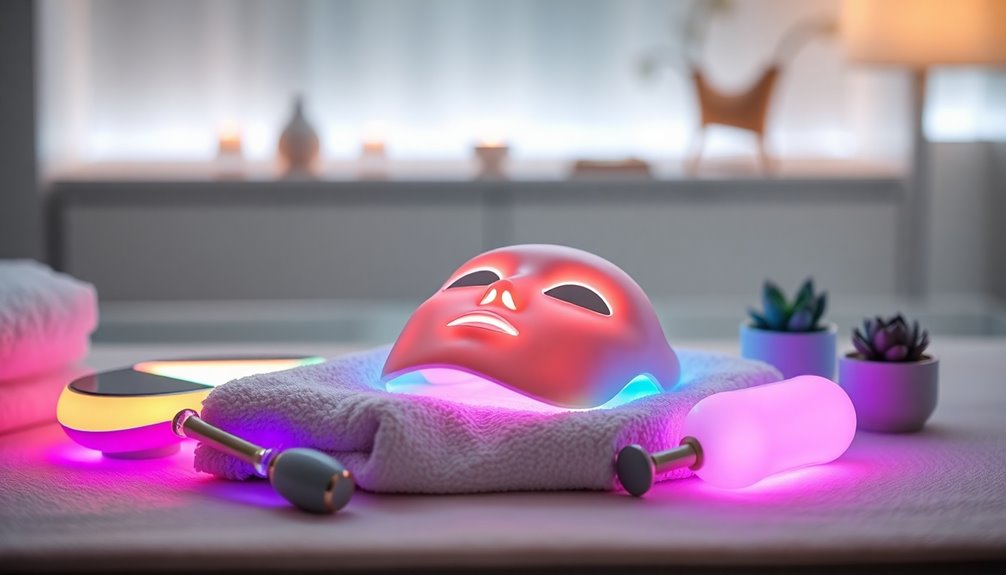
Although many people are curious about LED light therapy, misconceptions often cloud its benefits and effectiveness. One common myth is that it's harmful to your skin, but LED light therapy is safe and non-invasive, using specific wavelengths that don't damage skin or increase cancer risk. Additionally, extensive research supports its safety profile, reassuring users of its gentle nature.
Another misconception is that it's only for acne; in reality, it treats various issues like fine lines and rosacea. Not all devices are the same—quality and customization matter for effective treatment.
Many believe it's a quick fix, but consistency over time is essential for results. Lastly, you don't need to break the bank; there are affordable, effective options available for at-home use.
Professional vs. At-Home Devices
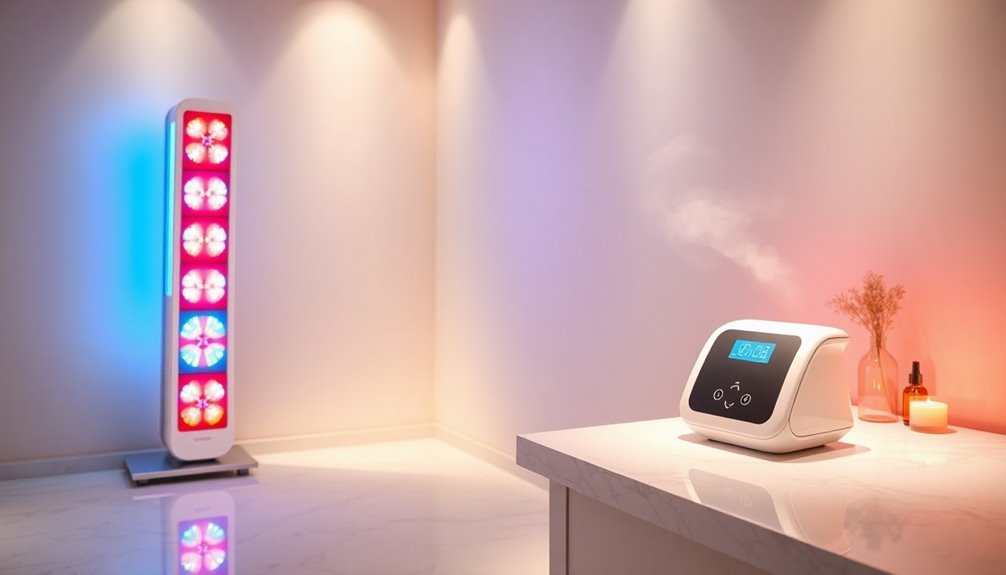
When deciding between professional and at-home LED light therapy devices, it’s essential to understand the differences in technology, power, and treatment options. Professional LED light therapy devices typically offer more advanced technology and greater power output, resulting in faster and more intensive treatments. On the other hand, at-home devices provide convenience and accessibility, allowing users to incorporate treatments into their daily routines. For those seeking effective results without leaving the comfort of their home, it’s important to research the best athome led therapy options to ensure a beneficial experience.
Professional devices boast advanced features like Optical Lens Array Technology, delivering powerful treatments with customizable settings. They can effectively treat larger areas and a variety of skin concerns under expert guidance. Additionally, many professional devices are FDA-cleared devices ensuring safety and efficacy in their use.
In contrast, at-home devices offer convenience and cost-effectiveness, allowing you to maintain your skincare routine from the comfort of home.
However, they typically have lower power outputs and smaller treatment areas, requiring longer sessions for results. While at-home devices are safe for regular use, they may not provide the same level of effectiveness or customization as their professional counterparts.
Choose based on your needs and preferences!
Combining Treatments for Enhanced Results
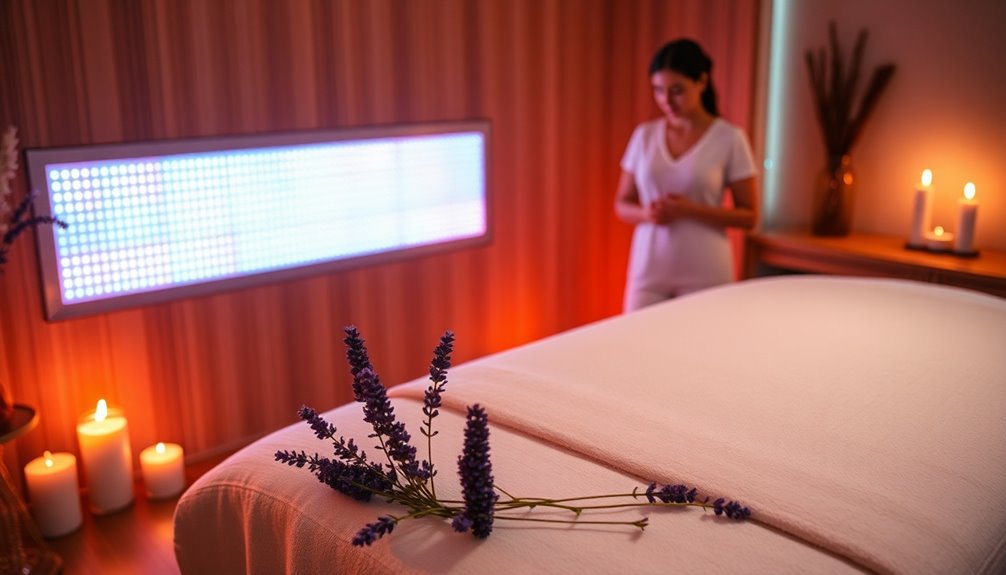
While choosing between professional and at-home LED devices is important, you can enhance your skincare results even further by combining treatments.
For instance, microneedling creates micro-channels in your skin, allowing serums to penetrate deeper. When paired with LED light therapy, you boost absorption and cellular function, leading to healthier skin. This combination also stimulates collagen and elastin production, which is essential for skin rejuvenation.
Both microneedling and red LED light stimulate collagen production, resulting in firmer skin and improved texture.
Plus, if you struggle with acne, combining microneedling with blue LED light effectively targets bacteria while reducing inflammation. This duo addresses both surface and deeper skin issues, promoting faster healing and minimizing redness.
Safety Considerations
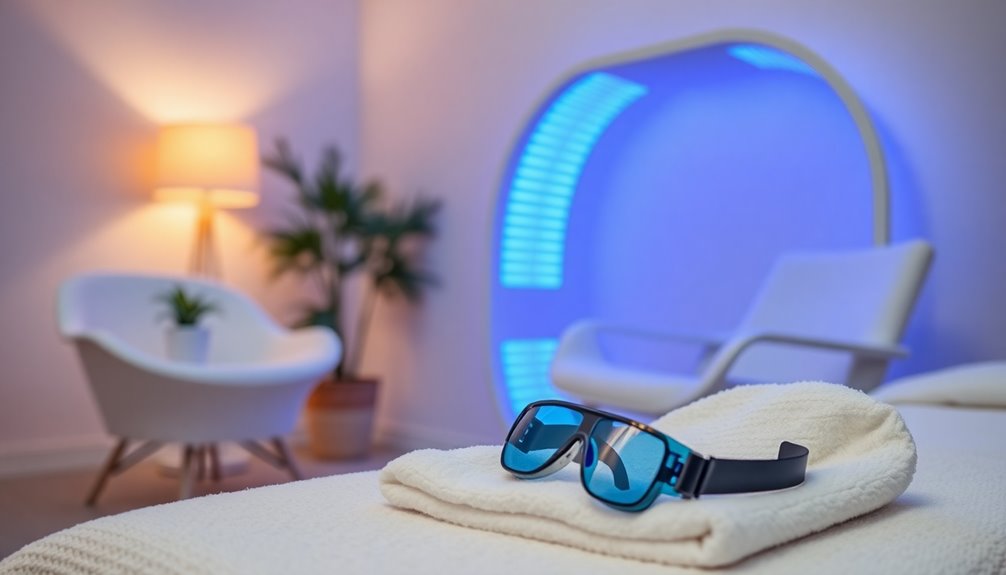
Have you considered the safety aspects of LED light therapy? While it can offer great benefits, understanding potential risks is crucial. Overuse may lead to skin irritation, causing redness or dryness.
Always protect your eyes with goggles, as direct exposure can result in fatigue or damage. If you have conditions like lupus or epilepsy, consult a healthcare provider before starting treatment. Some medications can increase your skin's sensitivity to light, so be cautious. Pregnant or nursing? It's best to avoid LED therapy due to limited research.
Start with shorter sessions and follow the manufacturer's guidelines to ensure safety. Remember, proper skin preparation and post-treatment care are essential for optimal results. Using FDA-approved devices is also crucial for ensuring safety and efficacy in your LED light therapy journey.
Choosing the Right Device

How do you choose the right LED light therapy device for your needs? Start by determining the type of therapy you require—red light is great for skin rejuvenation and surface issues, while near-infrared (NIR) targets deeper inflammation.
Consider combo devices for versatility. Next, evaluate the device's features: larger panels treat broader areas, while handheld options focus on specific problems. Devices like the TrueLight® Energy Trism™ provide natural healing benefits in just 20-30 minutes daily, making them an excellent choice for those looking to enhance their wellness routine.
Look for devices with more LEDs for efficiency and check for light modes; pulsating modes can enhance healing. Don't forget about portability—cordless and USB-rechargeable devices offer convenience.
Lastly, compare brands like TrueLight, HealthLight, and reVive to find one that suits your budget and quality expectations.
Tips for Effective Use
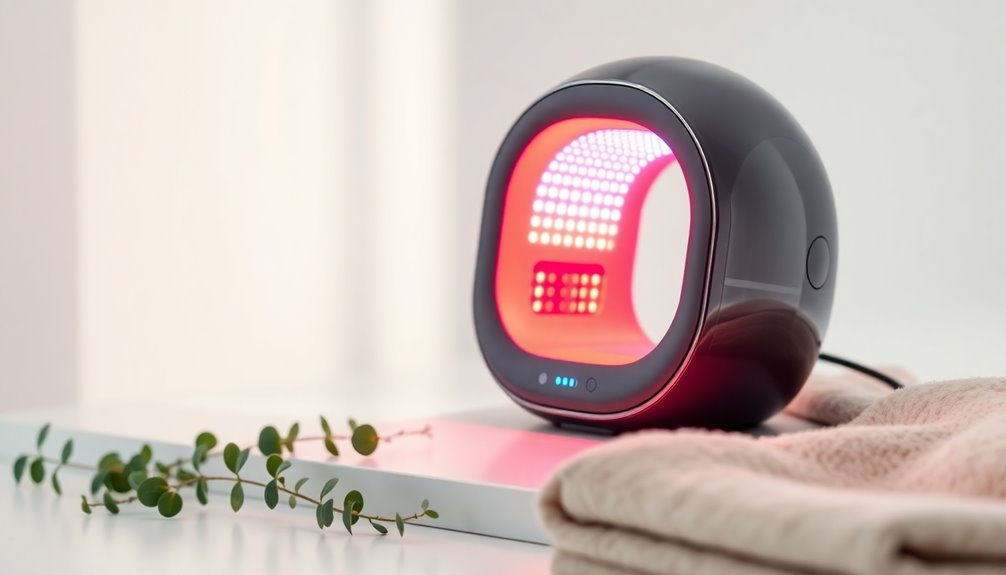
After choosing the right LED light therapy device, the next step is to maximize its benefits through effective use.
Consistency is key; aim for daily sessions, even up to three times a day, to see faster results. Always start with a clean face—sunscreen can block light wavelengths, so ensure your skin is free of any residues. Exfoliating before treatment can further enhance effectiveness. Additionally, it's important to conduct a patch test for skin sensitivity before regular use to ensure compatibility with your skin.
Consider combining therapies; using vitamin C or retinol can amplify results. After your session, apply serums to lock in benefits.
Remember to care for your device by turning it off when not in use and cleaning it regularly. Proper maintenance will ensure your device lasts longer and functions optimally.
Frequently Asked Questions
How Often Should I Use LED Light Therapy for Best Results?
To get the best results from LED light therapy, start with 3-4 sessions a week for 4-6 weeks, each lasting 5-15 minutes.
After the initial period, you can maintain your progress with once or twice weekly sessions.
Remember, the frequency might vary based on the specific condition you're treating and your skin's sensitivity, so adjust accordingly.
Always monitor your skin's response to find the right balance for you.
Can I Use LED Light Therapy With Makeup On?
You shouldn't use LED light therapy with makeup on.
Makeup can block light penetration, reducing the treatment's effectiveness. For optimal results, start with a clean face, allowing the light to directly reach your skin.
If you need to wear makeup, try using lightweight, non-comedogenic products, but it's best to do your LED therapy before applying anything.
This way, you'll ensure your skin absorbs the light energy effectively and reaps the full benefits.
Is LED Light Therapy Safe During Pregnancy?
You might be wondering if LED light therapy is safe during pregnancy.
Generally, it's considered low-risk and non-invasive, lacking harmful UV rays. However, it's crucial to consult your healthcare provider for personalized advice.
Choose reputable devices that don't generate significant heat, and monitor your body's response.
While some benefits, like mood enhancement and skin improvement, exist, always prioritize your comfort and follow professional guidance throughout your pregnancy journey.
How Long Does Each LED Light Therapy Session Last?
Each LED light therapy session typically lasts between 10 to 30 minutes, depending on your specific needs and the intensity of the light.
For skin rejuvenation, aim for 10-20 minutes, while acne treatment might require 15-20 minutes.
It's essential to be consistent, so try to schedule sessions 3-5 times a week.
Always start with shorter sessions and adjust based on how your skin responds to avoid discomfort or strain.
Are There Any Side Effects Associated With LED Light Therapy?
When it comes to LED light therapy, you might be walking on thin ice if you're not aware of potential side effects.
Common issues include redness, swelling, and dryness, especially if your skin's sensitive. You could also experience itching or eye strain without proper protection.
Rarely, you may face blistering or temporary acne flare-ups.
Always consult your healthcare provider, especially if you're on medications or have pre-existing conditions, to mitigate risks.
Conclusion
So, there you have it—LED light therapy, the magical solution that claims to fix everything from wrinkles to your questionable life choices. While it won't save you from bad decisions or that third slice of cake, it can definitely brighten your skin! Just remember to pick the right device and don't forget sunscreen, because glowing skin doesn't mean you're immune to sunburn. Now, go forth and bask in your newfound glow, but maybe skip the "glow" filter on social media!

